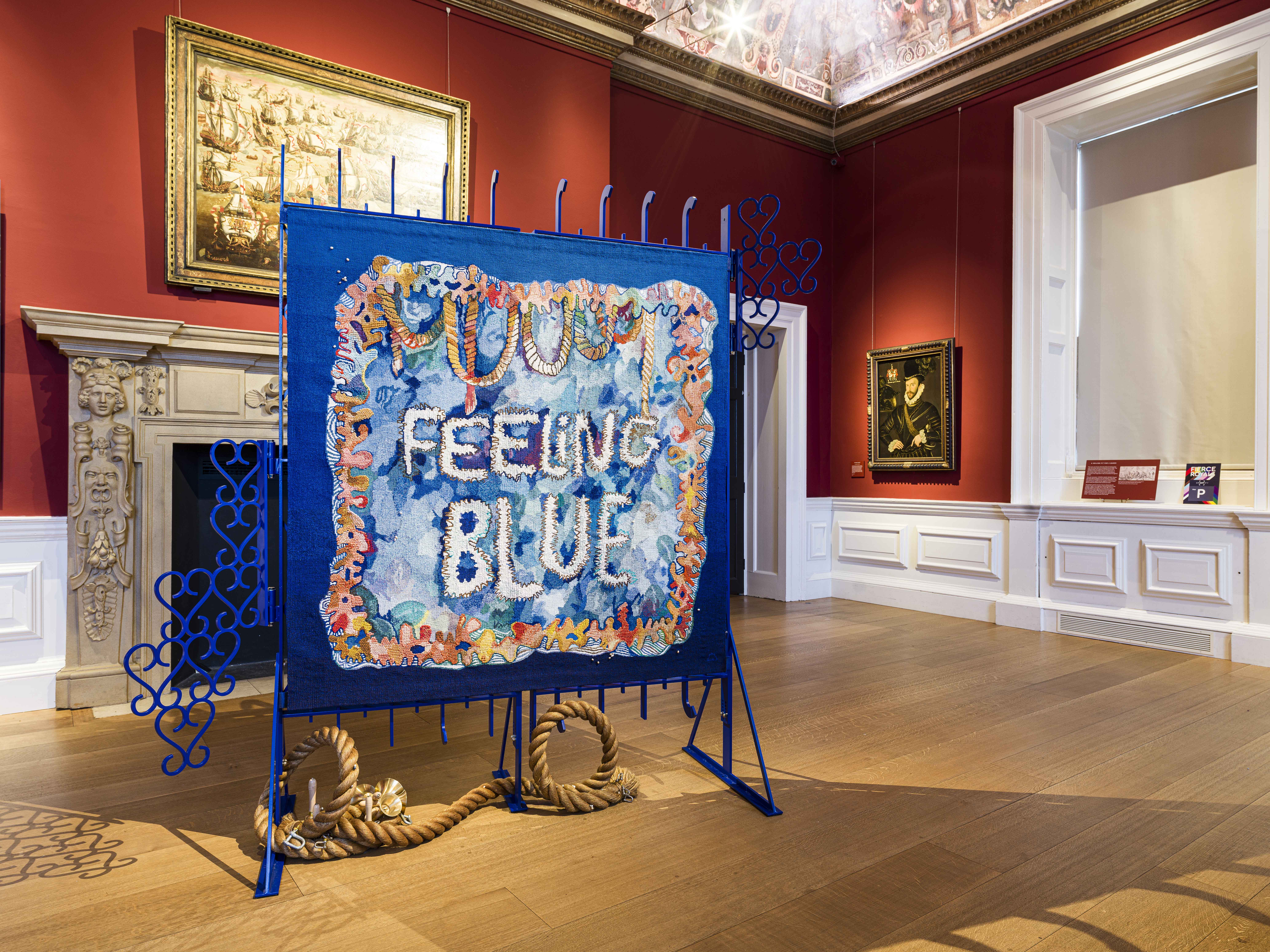


Courtesy Alberta Whittle and Dovecot Studios. Photo: National Maritime Museum, Greenwich, London.
Queen’s House, National Maritime Museum, Royal Museums Greenwich
Permanent Display
The Scottish-Barbadian artist Alberta Whittle is widely recognised for her artistic practice, which explores the legacies of the Trans-Atlantic slave trade, and its connections to present day institutional racism, white supremacy, and the climate emergency. Her multifaceted oeuvre, encompassing film, sculpture, etching, photography, textile, and painting foregrounds hope by engaging with various forms of resistance in the face of an oppressive political climate.
In 2021, Whittle was commissioned to create a significant new tapestry in response to the historic art collection of the Queen’s House, Greenwich.
This tapestry, titled Feeling Blue (2023), was meticulously handwoven over a period of six months by Naomi Robertson and Elaine Wilson at Dovecot Studios, Edinburgh. Feeling Blue employs a wide array of knotting and weaving techniques using various yarns, as well as more than 150 different colour blends to add diversity and depth to the tapestry's surface. It was publicly unveiled on October 5th.
Feeling Blue is free-standing in the midst of the Queen’s Presence Chamber, held taut by powder-coated steel gates. The words ‘feeling blue’ starkly stand out from a background of blues and greens - shades that remind us of vast oceans in motion. As I strolled around the textile-sculpture, I immediately associated the color blue with the maritime world. In the 17th Century Queen’s House, the first classical building in England, the color blue served as a predominant decorative element, particularly adorning the balustrade of the Tulip Stairs.
Yet, there are also deeper, emotive connotations that Whittle has chosen to highlight and explore. The colour blue and the phrase ‘feeling blue’ are associated with sadness. Although the exact origin of the term is unclear, it may have derived from the tradition of ships flying blue flags and officers donning a blue band when a high-ranking crew member has died. Additionally, in the mid-18th Century, the Royal Navy introduced a naval uniform for officers made from a deep blue fabric, achieved using a dye from the indigo plant native to India. Until the end of the 18th Century, indigo plants were grown, harvested, and processed by enslaved people in North America as well as by indentured labourers in India and modern-day Bangladesh. Up until today, Navy blue continues to symbolise authority, being utilised, for example, in the uniforms of police and military officers.
Whittle further continues her exploration of the links between colonialism and the nautical world by including coloured ropes – reminiscent of those used on ships. For Whittle, a rope symbolises both hope and oppression. Her continued engagement with the climate crisis is found in the decorative coral that frames the tapestry. Delicate pastel pinks and vibrant yellow shades evoke the beauty of tropical oceans, reminding us about the importance of coral reefs in our ecosystem. Iridescent, cultured freshwater pearl beads have also been stitched onto the tapestry, connecting Feeling Blue with two sixteenth-century paintings – the Armada Portrait of Queen Elizabeth I and Marcus Gheeraerts’ portrait of Sir Francis Drake - which are presented alongside the tapestry. In both portraits pearls, some of which were undoubtedly obtained through colonial trade and exploitation, are used as a symbol of wealth and power.
Whittle’s commission is a reminder of the contemporary significance of tapestry as a medium. For the artist, the commission has been an opportunity to think deeply about maritime histories and consider the powers that decide how these histories are portrayed. The vivid tapestry Feeling Blue - on long-term display - not only invites us to explore notions of power alongside the rhythms of the sea, but also to reflect on the vulnerability of the oceans in a time of climate crisis.
Christine Takengny
The Roden Senior Curator, Museums Acquisitions
Queen’s House
National Maritime Museum, Royal Museums Greenwich, Romney Rd, London SE10 9NF
Opening Times: Monday – Sunday from 10am to 5pm